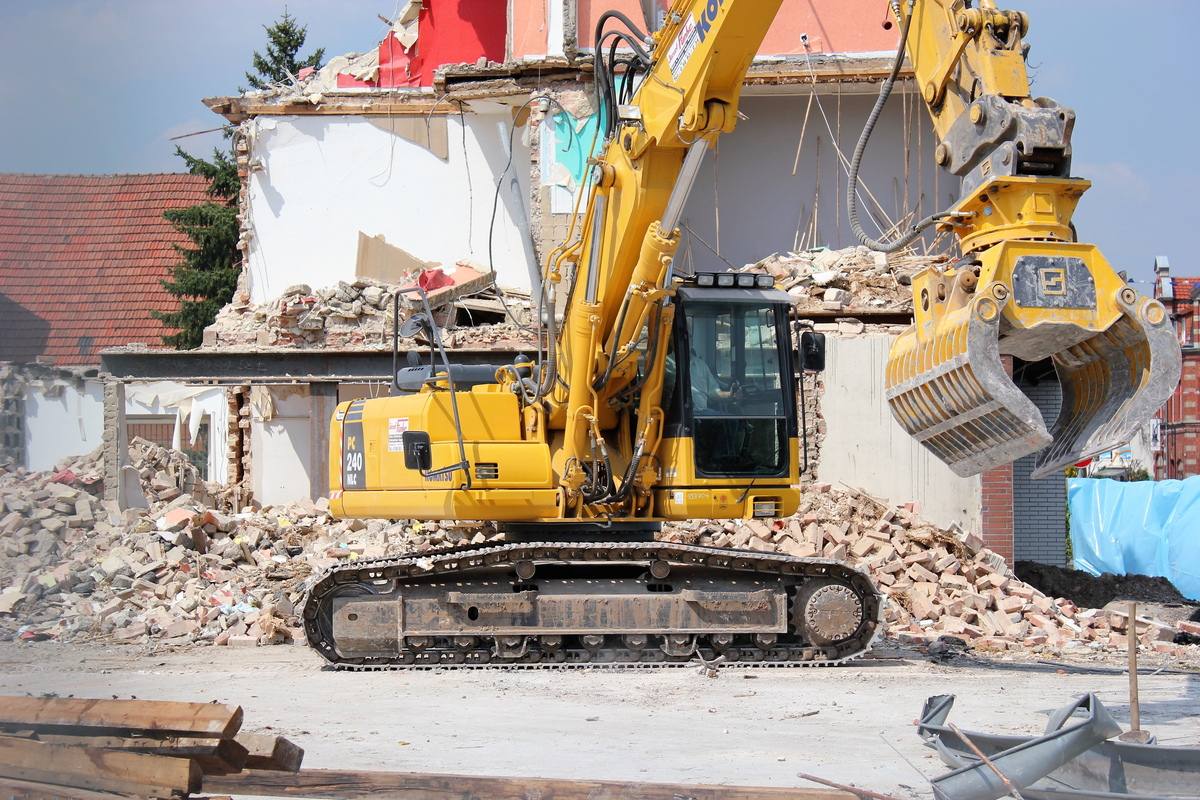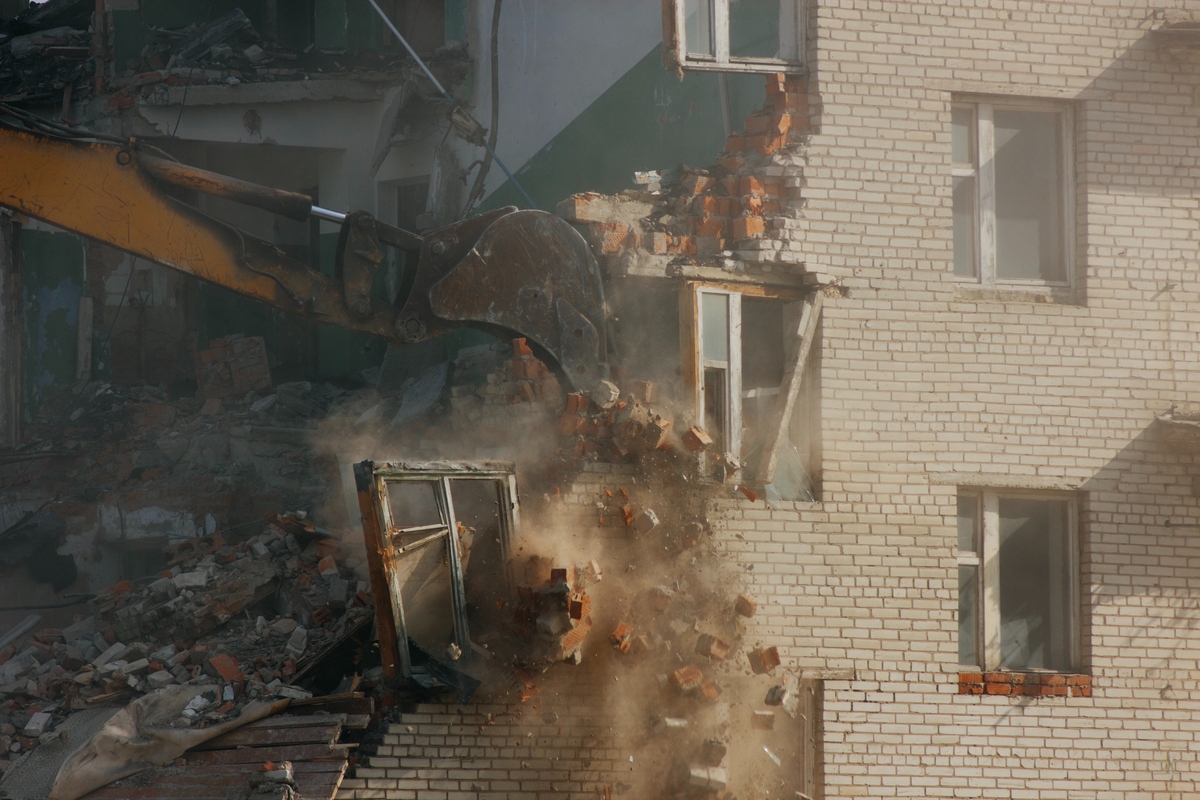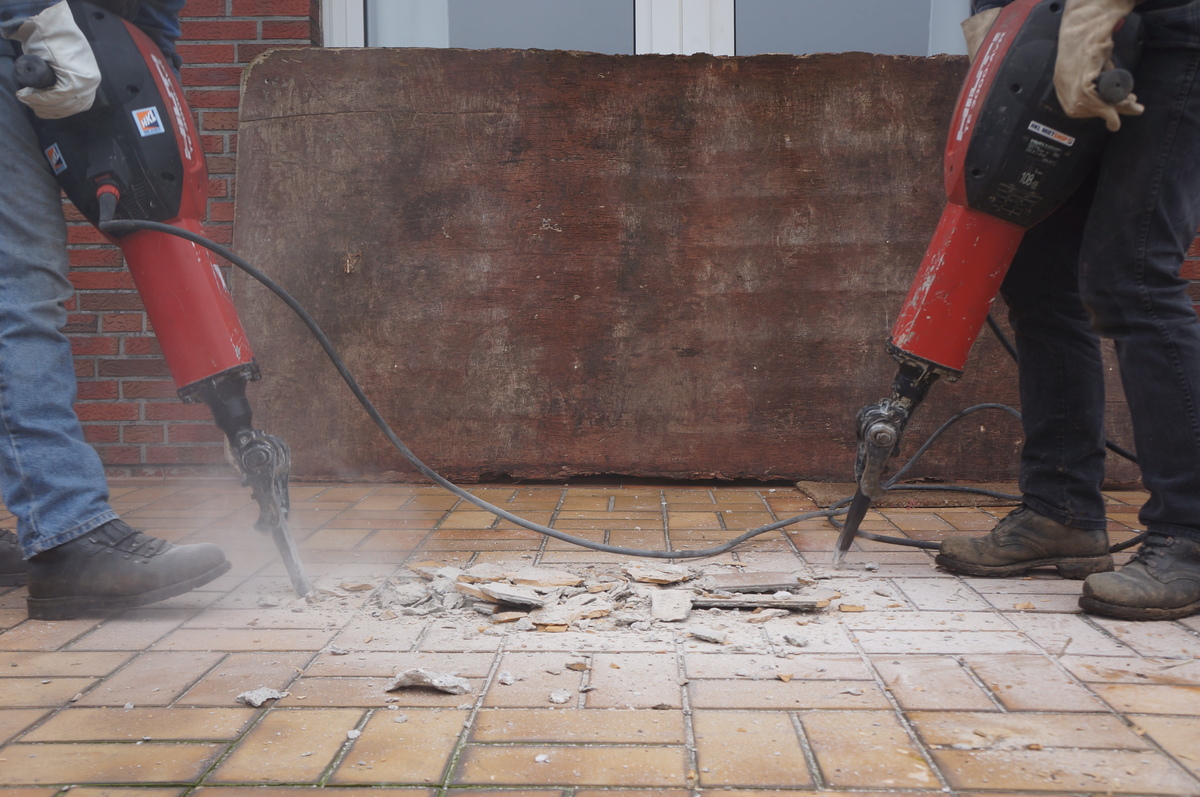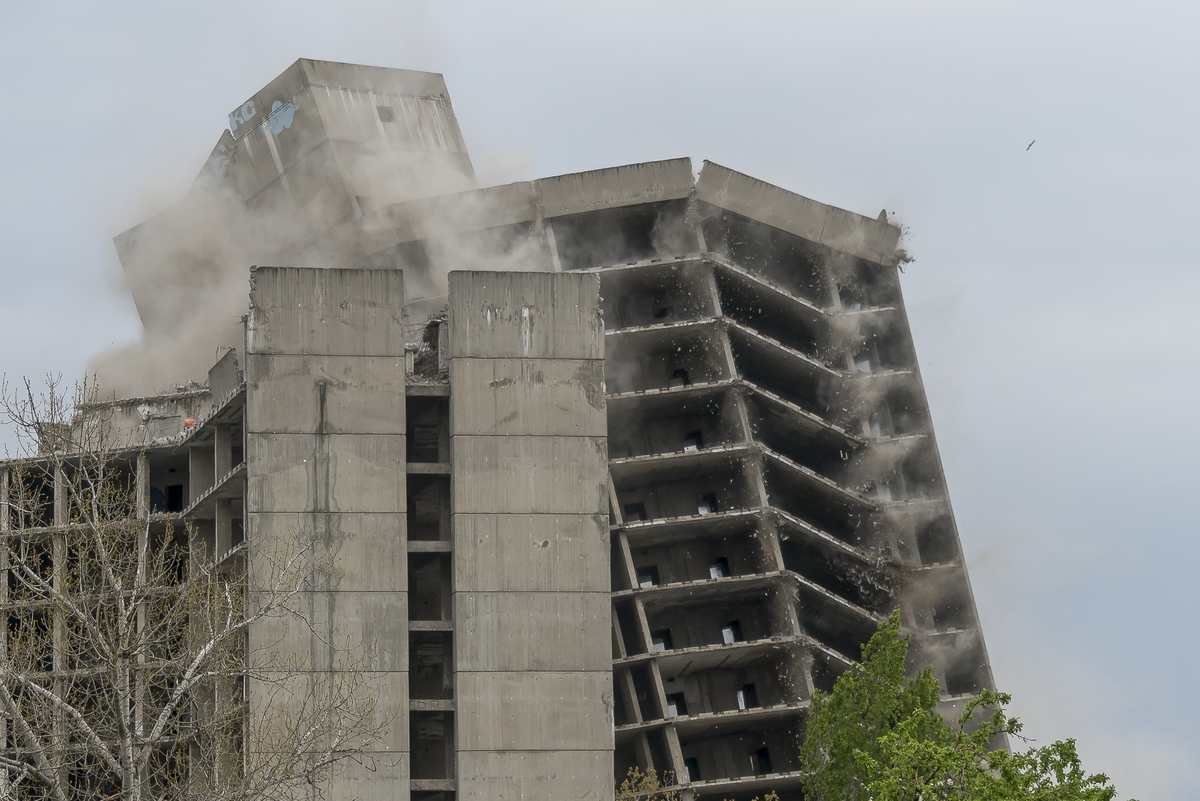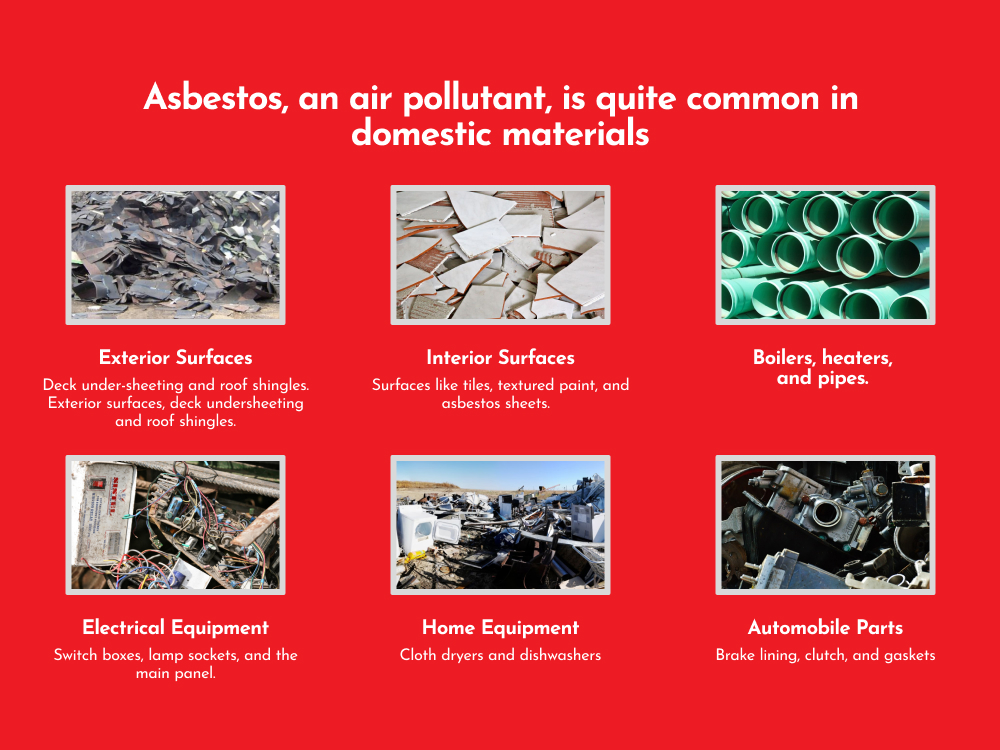Home demolition is not the backbreaking task you think it is, but it is not a breeze either.
From assessing your property and obtaining permits to selecting the right demolition contractor, there are essential steps to follow to get the job done right.
Here, we will carefully cover everything a homeowner needs to consider and do for a successful home demolition.
Table of Contents
- What to do Pre-demolition
- How to Salvage and Recycle
- How to handle Waste Disposal and Site Cleanup
- What to do Post-demolition
- Cheap ways to demolish your house
Pre-Demolition: What to do
A proper demolition starts with thorough preparations. Here’s a breakdown of the key steps involved:
Choose the Right Demolition Method:
Depending on the scope of the project and your choices, you can demolish a house in three different ways:
Mechanical Demolition

Mechanical demolition involves using heavy machinery, such as excavators and bulldozers, to raze down the structure.
This method is cheaper and faster than deconstruction. It’s also practical for larger structures and sites where space is not a constraint.
It’s, however, not as environmental-friendly and would generate more noise and vibrations.
Manual Demolition

Manual demolition, or deconstruction, involves labor-intensive work using hand tools and careful dismantling.
Parts of the building, such as doors, windows, light fixtures, and sinks, are removed individually to be recycled or sold.
This method is suitable for smaller structures or situations where salvaging reusable materials and recycling are priorities. But it is time-consuming and more expensive than mechanical demolition.
Controlled Demolition

Controlled demolition uses precise techniques like hydraulic drilling and explosives to bring down heavy structures with minimal impact on surrounding areas.
This method is often used for skyscrapers, bridges, tall residential buildings, and cooling towers.
Achieving balance with mechanical demolition and deconstruction
Expert demolition contractors will recommend a mixture of mechanical demolition and deconstruction as the best method.
With the correct application, this method saves time and helps salvage select valuable materials. It’s also cost-efficient and environmental-friendly.
How much does it cost to demolish a house in Wisconsin
Based on data from multiple demolition contractor quotes, house demolition in Wisconsin costs between $7,700 and $17,500, depending on the size of the house.
Of course, exact prices are determined based on the nature of your specific project. The following factors will determine how much you pay for a home demolition:
- Asbestos removal: this will increase your budget.
- Terrain: rugged terrain or difficult access to the site means higher prices.
- Density of the area: projects in dense urban areas require more planning and compliance and are thus more expensive.
- Permit costs in your district.
- If the house has a basement: buildings with basements cost more.
- Local contractor and machine rental rates in your specific city.
- Local waste disposal costs.
- Tree removal: will raise the price.
Choose to Hire a Demolition Contractor or Go DIY
Small demolition projects like cabinet teardowns and small deck or patio removals might be handled DIY. If you have the tools and are comfortable using them, that is.
Even then, DIY demolition is quite time-consuming and carries a high risk of uncontrolled damage.
Most demolition projects, especially complete home demolitions or structural changes, are best left to professional contractors.
Advantages of DIY Demolition
- Potential cost savings by eliminating contractor fees.
Complete control over the project timeline and process.
- Flexibility to make on-the-spot decisions and adjustments.
Disadvantages of DIY Demolition
- Carries risk of non-compliance with state regulations due to lack of knowledge or proper research.
- Potential safety risks if you don’t follow proper precautions.Potential safety risks if proper precautions are not followed.
- Time-consuming and physically demanding, especially for larger projects.
Advantages of Hiring a Demolition Contractor:
- Professional expertise and experience in handling various types of demolitions.
- Compliance with safety regulations and proper disposal of hazardous materials.
- Efficient and streamlined process with access to specialized equipment and tools.
- Disadvantages of Hiring a Demolition Contractor:
- Costs associated with contractor fees and equipment rental.
- Less control over the project timeline and process.
To hire the right demolition contractor, you should:
- Get and compare at least three estimates from local demolition contractors in your area.
- Ensure the estimates are in writing and clarify who pays for and gets the required permits.
- Choose contractors that specialize in your specific home demolition project.
- Verify their license, insurance, and bond status.
- Get a written contract that outlines milestones, the contractor’s responsibilities, and payment schedules.
- Make payments per milestone.
Assess the Property
In most states, including Wisconsin, you are required to assess your property meticulously to identify potential environmental hazards like asbestos. This process will also help you and the contractor understand the site’s specific requirements.
Your demolition contractor may offer to do the property assessment, or you might have to hire a professional inspector.
To be on the same page with the inspector and ensure a thorough evaluation, do the following:
- Engage professionals with expertise in structural engineering, environmental consulting, and hazardous materials assessment.
- Look for signs of structural weaknesses, such as cracks, shifting foundations, or compromised load-bearing elements.
- Identify potential hazardous materials, including asbestos, lead-based paint, or underground storage tanks.
- Consider the environmental impact and nearby ecosystems, such as protected species or sensitive habitats.
- Take note of any unique site challenges that may affect the demolition process, such as limited access or proximity to neighboring structures.

Obtain Permits
In most states, you need permits to perform a home demolition. In Wisconsin, you have to notify the Department of Natural Resources if your project meets certain specifications.
Contact your local building department or permit office to inquire about the specific permits required for house demolition in your area.
The requirements may vary depending on the location and size of the structure.
To get a demolition permit in Milwaukee, you will need to submit several documents, such as an erosion control plan, a certificate of insurance, and a signed water affidavit.
The application process is lengthy and has to be done by a demolition contractor.
Disconnect Utility Services
Before commencing the demolition, you must disconnect utility services to ensure safety and avoid potential accidents.
Contact utility companies (water, gas, and electricity) to schedule the disconnection. Follow their instructions on how to properly shut off services and remove any utility connections from the property.
Coordinate with utility providers in advance to avoid delays or disruptions during the demolition process.
Secure the Site and Ensure Safety for Neighbors:
The demolition site needs to be secure to ensure the safety of both workers and neighbors.
Demo contractors typically erect sturdy fencing around the property to prevent unauthorized access and contain the debris.
Warning signs and barricades should be placed to alert pedestrians and drivers about the demolition work.
You should inform your neighbors of the upcoming demolition and any potential disruptions they may experience. Address their concerns and provide contact information for inquiries or emergencies.
Salvage and Recycle
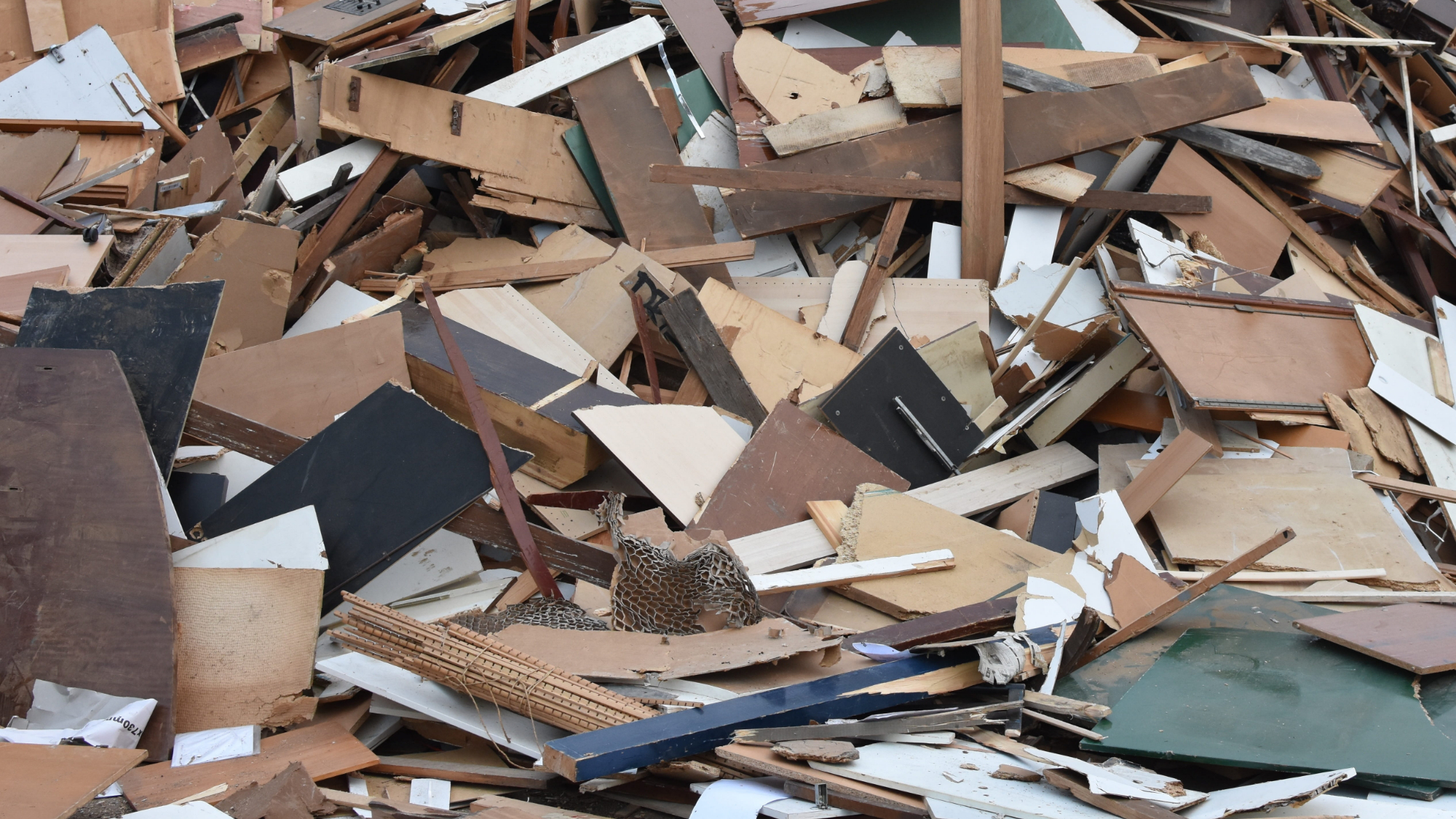
To salvage useful materials and adopt an eco-friendly demolition process, do the following:
Identify Salvageable Materials
Before demolition begins, carefully assess the property to identify materials that can be salvaged and reused.
Everyday salvageable items include doors, windows, fixtures, cabinets, flooring, and architectural elements like moldings and trim.
Take note of their condition and determine if they can be repurposed or donated to organizations like Habitat for Humanity or local building material reuse centers.
Use Proper Salvage Techniques
To maximize salvage efforts, adopt proper techniques for removing salvageable materials. For example, when removing doors or windows, be careful not to damage the surrounding framework or glass.
Label and store salvaged items in a safe location, ensuring they are protected from weather elements and potential damage during the demolition process.
Work with Local Recycling Centers
Collaborate with local recycling centers to responsibly dispose of unsalvageable materials.
Many centers accept concrete, metal, wood, and plastic construction materials. Research and contact recycling centers in your area to understand their specific requirements for accepting construction waste.
Some recycling centers may even offer pick-up services or provide guidance on sorting and preparing materials for recycling.
Waste Disposal and Site Cleanup
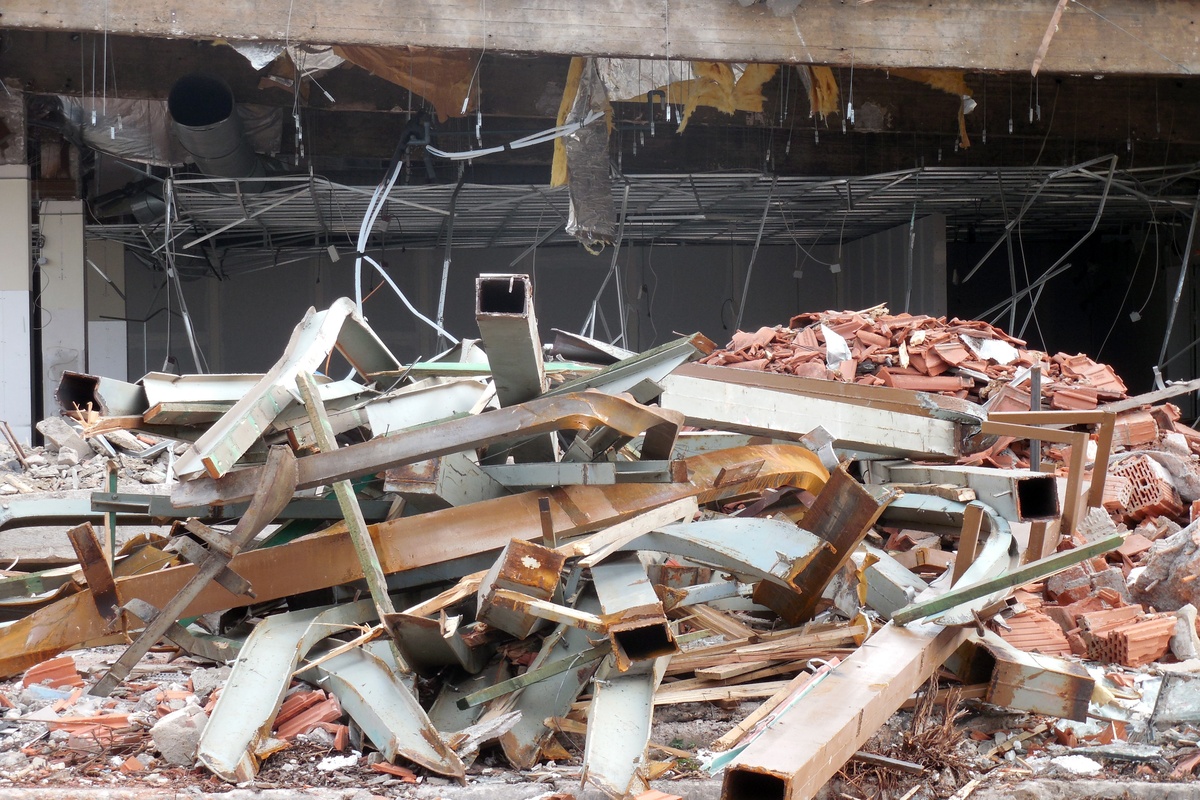
You might need to be involved with managing and disposing of waste from the demolition. Here are a few things to discuss with your contractor:
Waste Segregation
This involves sorting and separating materials on-site for easier recycling and proper disposal.
Waste can be categorized into different groups: wood, concrete, metal, and plastic.
Recycling
Maximize recycling efforts by identifying materials suitable for recycling. Concrete and bricks can be crushed and used as aggregate for future construction projects.
Metals like steel and copper can be recycled at local recycling centers. Seek recycling facilities that accept various construction materials and establish a partnership for smooth recycling operations.
Managing Hazardous Materials
Hazardous materials like asbestos will require special removal processes.
To control the asbestos emissions, contractors might wet the asbestos-containing materials or use an exhaust ventilation and collection system designed to capture such emissions.
All asbestos materials are to be sealed in leak-tight containers, treated for disposal, and transported to specific waste disposal sites.
Renting a Dumpster

You would typically need to rent a dumpster, which is the most effective way to handle demolition waste. Here’s a closer look at how a dumpster rental can streamline waste disposal and site cleanup:
It’s more convenient
Using a local dumpster rental service for an extended period eliminates the need for multiple trips to disposal sites, saving time, effort, and transportation costs.
It offers cost-effective options
Dumpster companies offer a range of dumpster sizes to fit the size and scope of your project. Assess the volume and type of waste you expect to generate during the demolition. This information will help you select the most cost-effective dumpster size.
Waste segregation is efficiently handled
Dumpster rentals take care of waste segregation and ensure that recyclable materials, such as concrete, metal, and wood, are quickly sorted and sent to the appropriate recycling facilities.
Ensures compliance and environmentally friendly practices:
Reputable dumpster rental companies will handle disposal in compliance with local regulations. Many companies partner with recycling facilities to ensure recyclable materials are diverted from landfills.
You will have to think about the number of dumpsters to rent for your home demolition. This will largely depend on the size and scope of your project.
A good dumpster rental service will assess your project and provide practical recommendations. If you live within West Allis and Waukesha County and need roll-off dumpster services for your demolition, contact Speedy Dumps, and we’ll be happy to help.
Post Demolition
Once the building is demolished, you will have to prepare the site for future use or construction. Here are some steps you might take:
Restore the Site
Restoring the site involves returning it to its original condition, ready for future use or construction.
Level any uneven surfaces, fill in excavated areas, and remove any remaining foundations or structures.
Consider landscaping options to enhance the appearance of the site. This could include planting grass, shrubs, or trees or implementing erosion control measures to prevent soil erosion.
Soil Remediation
Depending on the previous use of the property and the materials present during demolition, soil remediation may be necessary.
Some older structures may have contained hazardous substances like lead-based paint or asbestos, which can contaminate the soil.
Engage environmental professionals to assess the soil quality and conduct necessary remediation if required. This ensures the safety and integrity of the site for future use.
Cheap Ways To Demolish Your House
As you may have learned, home demolition can be rather expensive. Thankfully, there are cheaper ways to do it. The following options can offset some or even most of the associated costs:
Fire Department Training
Many fire departments offer training exercises that involve controlled burns and structural collapses.
These training exercises allow firefighters to practice their skills while also helping homeowners with their demolition needs.
Contact your local fire department and inquire about their training programs. Keep in mind that not all fire departments offer this service, and it may depend on their availability and specific regulations.
Demolition Material Recycling
Consider reaching out to local recycling companies or salvage yards to explore the possibility of selling or donating the materials from your demolished house.
Materials such as bricks, wood, metals, and fixtures can often be recycled or repurposed, reducing waste and potentially saving some demolition expenses.
Some companies may even be willing to provide a partial or complete demolition service in exchange for salvaging valuable materials.
Vocational College Partnerships
Consider partnering with vocational colleges or trade schools in your area that offer construction or demolition-related programs.
These institutions often seek real-world projects for their students to gain hands-on experience.
Contact the program coordinators and discuss the possibility of collaborating on your house demolition project. Under the supervision of their instructors, students may be able to assist with the demolition process at a reduced cost or even for free.
Habitat for Humanity
Consider reaching out to local chapters of Habitat for Humanity, a nonprofit organization focused on affordable housing.
They may be interested in salvaging reusable materials from your house to use in their housing projects. By donating materials, you contribute to a charitable cause and potentially reduce your demolition costs.


